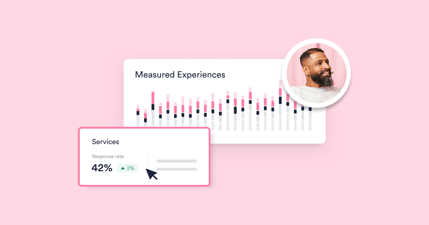How to Develop Channels with Experience Data in ServiceNow
Want to develop your IT channels in ServiceNow in a way that supports end-user and employee experience? You first need granular and accurate insights into how each channel is performing.
This is where experience data comes in.

How well is your IT self-service portal doing? Or your IT support chat channel? It’s likely that – as with many other organizations – your current set of IT metrics doesn’t provide sufficient insight into the employee experience across each of IT’s access and communication channels.
Meaning that your IT department might be trying to push employees to use a channel that offers them the worst service experience and causes them to lose the most productivity. Or your improvement investments are being plowed into channels that are already performing well rather than those with inferior experiences (and should be a priority for that investment).
If you want to effectively develop the IT support channels in ServiceNow – or those for other business functions – then there’s a need to measure performance (and success) in a way that gives more accurate and granular insights into how each channel is doing. Both now and going forward as changes and improvements are applied to up the service experience and adoption.
To help, this blog explains how your organization can develop channels with experience data in ServiceNow.
Getting “under the skin” of channel performance
You might already know the usage levels of different IT support channels. For example, the number of telephone calls, emails received, and chats with the IT service desk. Plus, the number of self-service portal or ServiceNow Virtual Agent interactions too. But how well are these and other channels performing? And not against some IT view of good or great, but in the eyes of the employees using them and what matters most to them. For example, your customer satisfaction (CSAT) scores might be good, but employees are still airing their issues with the self-service portal, say. Or simply not using the portal in the volumes expected (and needed to deliver the anticipated benefits).
This is where data-driven experience insight will help – allowing your organization to prioritize and undertake improvements relative to the relative performance of different IT support channels based on employee feedback (on their experiences and what matters most to them) rather than driving improvements through supply-side metrics and gut feelings.
Let’s “rip off the band-aid”
Do you want to know what employees think about the various IT support channels, in terms of what matters most to them? If so, then the table below shows this. But it’s also important to appreciate that these stats don’t relate to the average IT department, they relate to HappySignals customers that have already identified the need to improve the employee experience and have addressed their respective priorities in their time-to-date as a customer.
So, here goes…
Granular insight into the usage of the channels used for incident management
The results, in the table below, are based on HappySignals customers' data and are a rolling six-month average ending at the end of the indicated period.
IT Incidents: Channels used
| Q4/2019 | Q1/2020 | Q2/2020 | Q3/2020 | Q4/2020 | H1/2021* | |
| Chat | 8% | 7% | 8% | 8% | 9% | 8% |
| 20% | 19% | 18% | 17% | 17% | 16% | |
| Phone | 28% | 28% | 28% | 27% | 27% | 25% |
| Portal | 34% | 37% | 37% | 37% | 36% | 39% |
| Walk in | 4% | 4% | 3% | 2% | 2% | 2% |
*1.12.2020-31.5.2021
Source: HappySignals, The Global IT Experience Benchmark H1/2021
At first sight, these percentages might look great. After all, the low-cost self-service portal channel has grown in adoption, while the higher-cost telephone and email channel usage has declined. But this is just one perspective and the usage volumes are never likely going to be important to employees.
Instead, these are the two key elements of employee experience:
- Employee happiness
- Employee lost productivity
Before looking at the various channels from these perspectives, think about your current channel development strategy (or strategies) – are you looking to drive even more employee interactions via the self-service portal route? After all, self-service has long promised all three of “better, faster, cheaper” to IT departments that are looking to optimize their IT service delivery and support capabilities.
If so, then the following data sets should be a cause for concern.
Granular insight into employee happiness with the channels used for incident management
The results, shown in the table below, are again based on HappySignals customers' data and are a rolling six-month average ending at the end of the indicated period.
IT Incidents: Happiness for each Channel
| Q4/2019 | Q1/2020 | Q2/2020 | Q3/2020 | Q4/2020 | H1/2021* | |
| Chat | 62 | 61 | 64 | 68 | 70 | 74 |
| 67 | 66 | 68 | 73 | 73 | 75 | |
| Phone | 69 | 70 | 74 | 76 | 75 | 78 |
| Portal | 62 | 64 | 68 | 71 | 71 | 73 |
| Walk in | 90 | 89 | 90 | 91 | 90 | 92 |
*1.12.2020-31.5.2021
Source: HappySignals, The Global IT Experience Benchmark H1/2021
The portal channel has done much to improve its happiness standing over what’s close to the last two years, and especially during the times of remote working. But so have the other channels. For example, chat has seen the biggest increase over this timeframe.
It’s also important to remember that the averages shown above are for HappySignals customers that have been investing time, effort, and money in improving the employee experience of their channels. Such that they’re not representative of the picture for all organizations – where some channels might be faring significantly below others.
To demonstrate this, but still using HappySignals customer data, the following table shows the wide range of employee lost productivity across channels.
Granular insight into employee lost productivity for the channels used for incident management
Before viewing the aggregated employee feedback data, it’s worth talking about the importance of employee productivity as a factor in determining the employee experience. Here, a Forrester Research quote is a quick way to describe this:
“Psychological research shows that the most important factor for employee experience is being able to make progress every day toward the work that they believe is most important.”
That being able to be productive is a big part of what makes for a positive employee experience.
The HappySignals data shows this too – with employee happiness increasing as lost productivity drops and vice versa. The results, shown in the table below, are again a rolling six-month average ending at the end of the indicated period.
IT Incidents: Lost Time for each Channel
| Q4/2019 | Q1/2020 | Q2/2020 | Q3/2020 | Q4/2020 | H1/2021* | |
| Chat | 2h 40min | 3h 10min | 3h 15min | 3h 4min | 2h 36min | 2h 29min |
| 4h 00min | 3h 55min | 3h 43min | 3h 32min | 3h 35min | 3h 44min | |
| Phone | 2h 25min | 2h 30min | 2h 27min | 2h 19min | 2h 10min | 2h 3min |
| Portal | 4h 20min | 4h 34min | 4h 33min | 4h 28min | 4h 9min | 3h 59min |
| Walk in | 1h 11min | 1h 13min | 1h 30min | 1h 49min | 1h 37min | 1h 53min |
*1.12.2020-31.5.2021
Source: HappySignals, The Global IT Experience Benchmark H1/2021
Here the differences are more obvious. That, while the telephone channel is perceived to lose employees an average of two hours, the portal channel is close to double this – i.e. four hours of lost productivity. Making for a more negative employee experience that’s a potential barrier to portal adoption.
After all, if an issue is affecting their productivity, why would any employee actively seek to use a channel that takes twice as long to get productive again?
Digging deeper into channel-based experiences
Organizations can get insight into success and failure from both the HappySignals experience data and the ServiceNow operational data related to incident handling. Hence, in this instance, the cause of the portal channel delays can be investigated from two perspectives.
This could start, for example, with the identification of ticket reassignment issues – where having to reexplain the issue and provide details repeatedly, i.e. being bounced between support personnel, is a key contributing factor to end-user unhappiness and delays. This assignment impact is shown in the aggregated data below (which isn’t only related to the portal channel).
Impact of Ticket Reassignments
| Reassignment count | Happiness | Lost Time |
| 0 | 81 | 1h 58min |
| 1 | 75 | 3h 17min |
| 2 | 66 | 5h 8min |
| 3 | 56 | 6h 22min |
| 4 | 51 | 7h 49min |
*1.12.2020-31.5.2021
Source: HappySignals, The Global IT Experience Benchmark H1/2021
The more a ticket is reassigned, the unhappier an employee gets, and the more productivity they lose. But the big question is “Why are tickets being reassigned?” (in the context of the portal in this instance).
Here, the analysis of ServiceNow data might show that the root cause is the incorrect categorization of tickets by the employees themselves – with a ticket then being routed to the wrong resolution group at the start of its reassignment journey and the unwanted consequences.
Using experience data to develop channels in ServiceNow
I could continue to talk about how best to handle such issues, using customer-based findings to do so, but this blog is about how to develop channels with experience data in ServiceNow.
So, hopefully, you’ve been able to see that your traditional IT metrics might be hiding underlying issues that provide a poor experience and increased levels of employee lost productivity. Plus, that if you’re currently looking to drive more employee interactions via the portal channel route, say, and your organization has similar issues, then you’re likely making a suboptimal decision that will adversely affect business operations and outcomes (despite the decision being made for the right reasons).
With experience data – both alone and in conjunction with ServiceNow operational data – your organization can make data-driven decisions on which channels to develop. Whether this development is improvement-related or the “pushing” of a channel’s use to benefit all.
This could, for example, be the prioritization of the portal channel over email to reduce the delays and drive adoption up (and hopefully reducing the mindset of “It’s easier to just send an email”). Or greater investment in the chat channel. Or the justification of your organization’s ServiceNow Virtual Agent rollout based on real experience data that includes channel-specific happiness, the estimated employee lost time, the services involved, and the key issues and their contributing factors.
Want to find out more about using experience data to help your organization develop channels within ServiceNow?
Watch this 3-min video on how HappySignals makes it easy to do so!
Related content

28.03.2024
The Dangers of Relying on DEX Tools Alone
If you look at the various solutions offered in the employee experience market, you’ll notice two main approaches – a ...
Read more >
15.05.2019
Interview with Alan Norris from ServiceNow
In this episode Sami Kallio meets Alan Norris, ISV Consultant at ServiceNow. They discuss how employee experience and ...
Read more >
